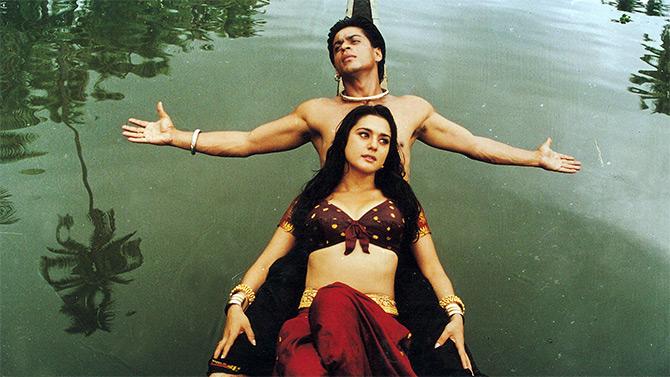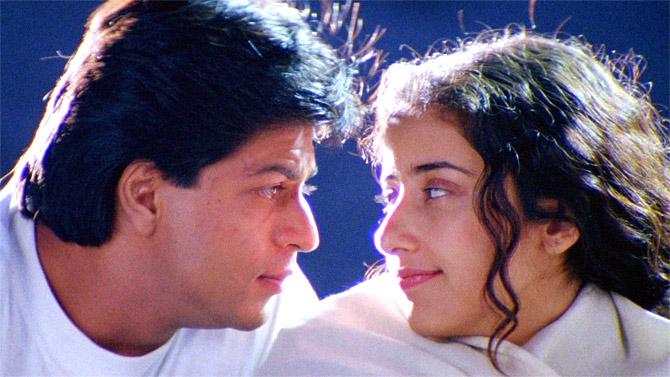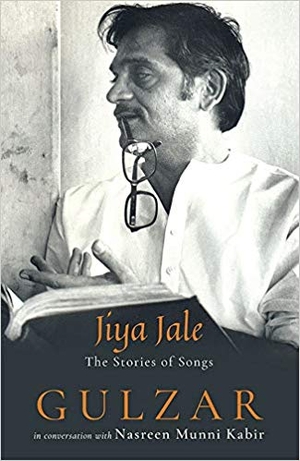'I believe after Shailendra's Mera Joota Hai Japaani in Raj Kapoor's Shree 420, Chhaiyyan Chhaiyyan is now the Indian film song that is recognised the world over -- millions know it as 'the train song'.'
A fascinating excerpt from Jiya Jale: The Stories of Songs by Gulzar, In conversation with Nasreen Munni Kabir.

Nasreen Munni Kabir: Your distinctive voice is in all your songs.
It takes a different turn in Chal Chhaiyyan Chhaiyyan.
I find this a particularly unique song from every angle.
Your lyrics, Mani Ratnam's direction, (A R) Rahman's music, Santosh Sivan's photography, Farah Khan's choreography, the performance by Shah Rukh Khan and Malaika Arora, the voices of Sukhwinder Singh and Sapna Awasthi, and not forgetting the train chugging through lush Ooty -- you have all conspired to make this a truly memorable piece of cinema.
Gulzar: When Shah Rukh heard the song, he fell in love with it. I am guessing that the words 'chhaiyyan chhaiyyaan' made them think of a chugging train (both laugh).
NMK: I believe after Shailendra's Mera Joota Hai Japaani in Raj Kapoor's Shree 420, Chhaiyyan Chhaiyyan is now the Indian film song that is recognised the world over -- millions know it as 'the train song'.
Sir Andrew Lloyd Webber once said in an interview that he had seen the Dil Se song clip on Channel 4 TV in the UK and it made him want to work with Rahman, which led to the production of the musical Bombay Dreams in London.
The song even popped up under the opening credits in Spike Lee's 2006 film Inside Man.
I remember seeing Inside Man on its release in Toronto, and when the song was heard at the start of the film, two young women wearing hijaabs jumped out of their seats and screamed 'Shah Rukh Khan!' You can imagine the reaction of the Canadian audience, who fell very silent (both laugh).
I must admit it is a difficult song to translate and am grateful for your help.
I remember reading a translation on the Net of the first line: 'Come, let us walk under the shadow, shadow, shadow, shadow.'
That's a lot of shadows to deal with!

G: Actually it is not 'shadow', it should be 'shade'!
Jinke sar ho ishq ki chhaaon
Those who walk in the shade of love...
Paaon ke neeche jannat hogi
...must have paradise beneath their feet
Jinke sar ho ishq ki chhaaon
Those who walk in the shade of love...
Chal chhaiyyan chhaiyyan chhaiyyan chhaiyyan
Come, let us walk in the shade of love
Sar-e-ishq ki chhaaon chal chhaiyyan chhaiyyan
Let us walk in the shade of love
Paaon jannat chale chal chhaiyyan chhaiyyan
Let paradise spread beneath your feet
Chal chhaiyyan chhaiyyan chhaiyyan chhaiyyan
Let us walk in the shade of love
Voh yaar hai jo khushboo ki tarah, jis ki zubaan Urdu ki tarah
The beloved friend is like a sweet aroma
whose words as elegant as Urdu
Meri shaam raat meri kaayenaat
My evening, my night, my universe...
Voh yaar mera sainyyan sainyyan
...that friend of mine is my beloved
Chal chhaiyyan chhaiyyan chhaiyyan chhaiyyan
Let us walk in the shade of love

NMK: I was struggling with the 'gulposh' line -- it was the most difficult line in the song.
But you explained it by telling me that 'posh' means attire or dressed in flowers, referring to God. I hope this works?
Gulposh kabhi itraaye kahin
meheke toh nazar aa jaaye kahin
The One draped in flowers will come into sight
as the fragrance spreads
Taaveez bana ke pehenoon usse
aayat ki tarah mil jaaye kahin
I shall wear an amulet, if the beloved
is found in holy verse
Voh yaar hai jo imaan ki tarah
My beloved is like faith itself
Mera naghma vohi, mera kalma vohi
My song, my prayer
Yaar misaal-e-uos chaley, paaon ke taley firdaus chaley
The beloved falls like dew,
paradise beneath the feet
Kabhi daal daal kabhi paat paat
Sometimes on the branches,
sometimes on the leaves
Main hawa pe dhoondoon uske nishaan
I search for traces of my beloved in the breeze
Sar-e-ishq ki chhaaon chal chhaiyyan chhaiyyan
Let us walk in the shade of love
Paaon jannat chale chal chhaiyyan chhaiyyan
Let paradise spread beneath your feet
Chal chhaiyyan chhaiyyan chhaiyyan chhaiyyan
Let us walk in the shade of love...
Main uske roop ka shehdaai
I am an admirer of the beloved's lovely form
Voh dhoop chhaaon sa harjaai
Voh shokh hai rang badalta hai
Fickle as the sun and shade.
Changing colour on a whim
Main rang-roop ka saudaai
I am enchanted by colour and form
Jinke sar ho ishq ki chhaaon
Those who walk in the shade of love...
Paaon ke neeche jannat hogi
...must have paradise beneath their feet
Meri shaam raat meri kaayenaat
My evening, my night, my universe...
Chal chhaiyyan chhaiyyan chaiyyan chaiyyan...

NMK: I was talking to Zakir Hussain about the line 'Gulposh kabhi itraaye kahin meheke toh nazar aa jaaye kahin', and he asked whether you were thinking of a dargah of a Sufi saint -- because a shrine is often covered with flowers.
G: The lines can suggest a dargah.
But the idea here is that God is hidden among the flowers -- gulposh literally means 'He has worn flowers'.
You can use abstract imagery when speaking of spirituality.
NMK: So draped in flowers is all right?
G: Yes, and so when the fragrance spreads then I know where God is hidden.
NMK: If I understand correctly, many of your songs talk of the 'experience of feeling,' rather than being a description of events.
G: (pauses) Absolutely right.
I am not trying to give a simile or paint an image -- I want to create an experience of feeling. And what is that feeling?
I might be fumbling to catch an image -- that fumbling itself becomes the expression.

Excerpted from Jiya Jale: The Stories of Songs by Gulzar, In conversation with Nasreen Munni Kabir, with the kind permission of the publishers, Speaking Tiger Publishing Pvt Ltd.











